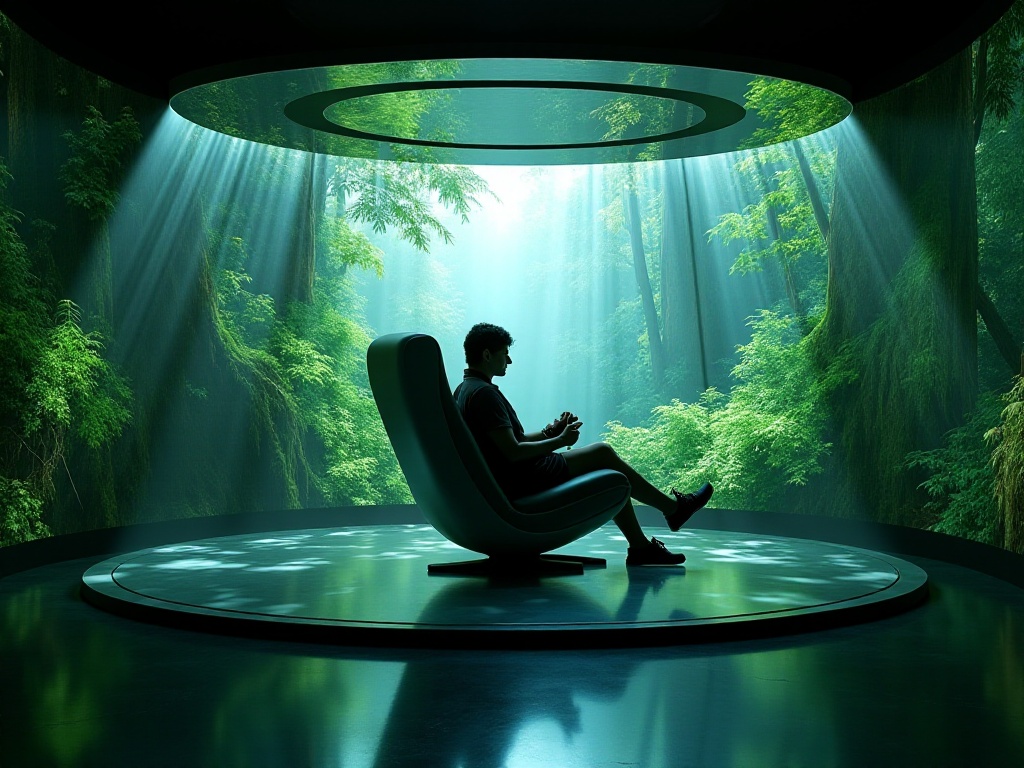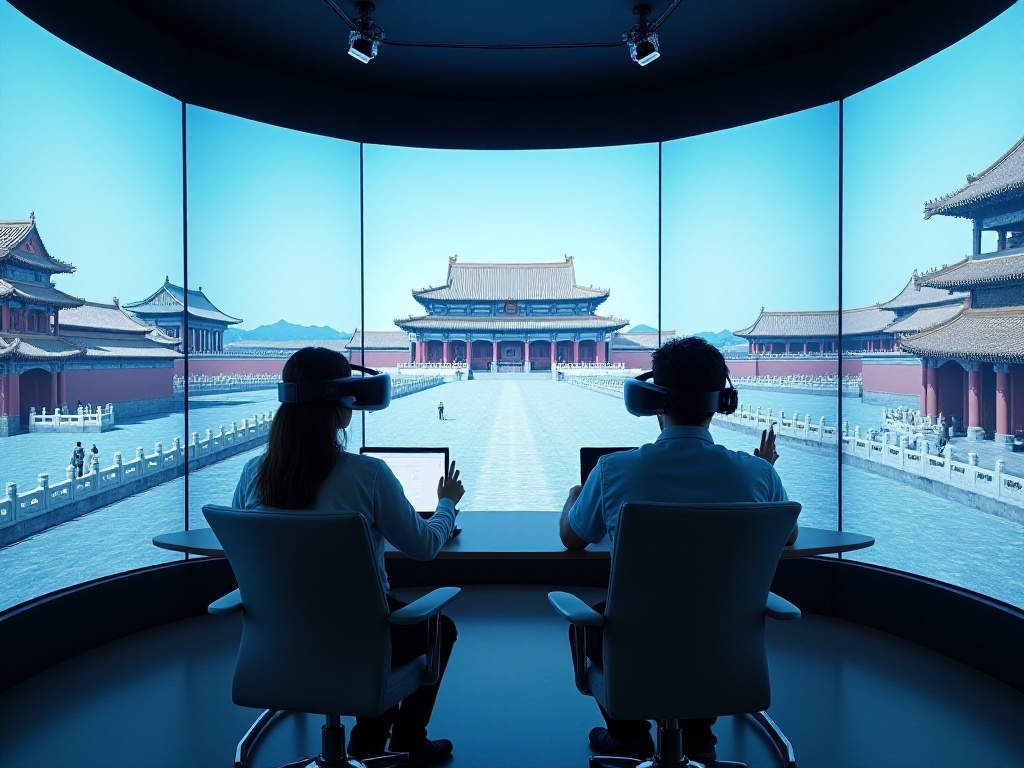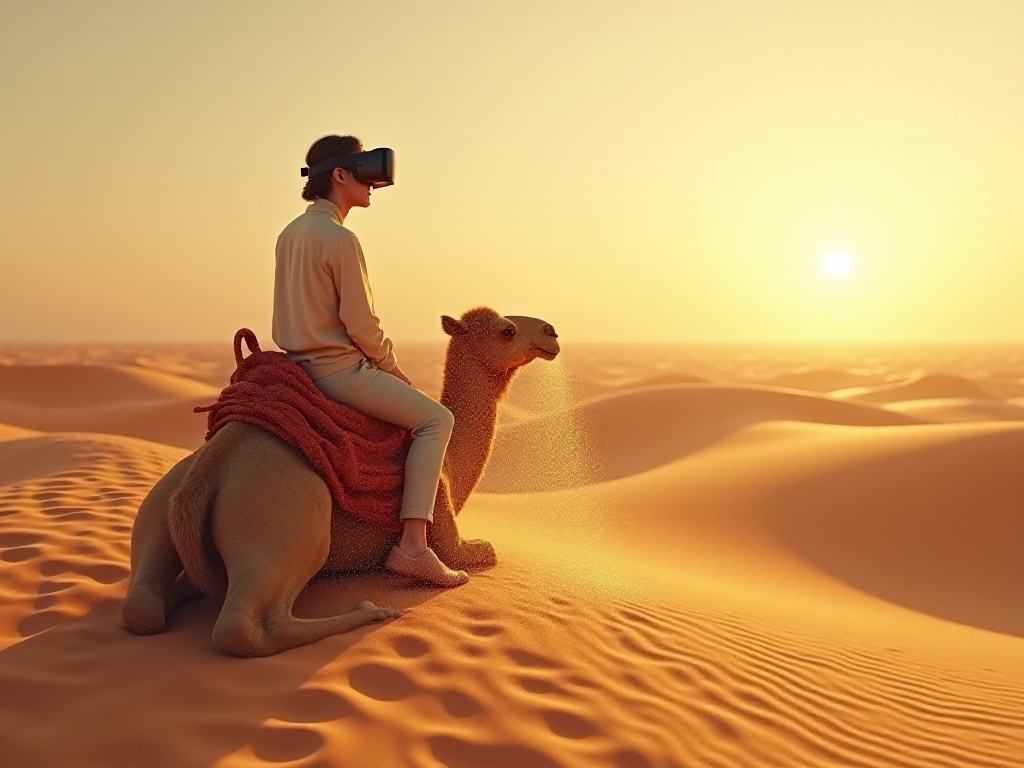One night as I lay in bed scrolling through my phone, I suddenly saw a news item: a tech company had launched their latest VR tourism experience. I immediately became excited and bought a VR headset online the next day. When I first put it on, I was absolutely amazed! I was instantly "transported" from my small apartment in Shanghai to the foot of the Eiffel Tower in Paris. Everything around me was incredibly lifelike: the tower gleaming with metallic luster in the sunlight, tourists looking around with their cameras, and the aroma wafting from nearby cafes. It felt just like being in Paris!
As someone who's deeply socially anxious but loves to travel, this seemed perfectly tailored for me! No need to interact with strangers, no language barriers, and the ability to start a spontaneous journey anytime, anywhere. This made me want to share this exciting topic - virtual tourism - with everyone.
The history of virtual tourism is quite an interesting story. It dates back to the 1980s, when my parents were still in college! Computers weren't as smart as they are now - screens were black and white, and monitors were big and clunky. But even in that era, the concept of virtual tourism was already emerging.
The earliest virtual tourism was basically just looking at photos and 360-degree panoramas on computers. The image quality back then was, well... let's just say it was very pixelated. But people found it amazing at the time! After all, in that era, to learn about the outside world, you had to either read books, watch TV, or go there in person.
In the 1990s, with the spread of the internet, virtual tourism took a quantum leap. People could now see photos and videos from around the world online. Though the internet speed was frustratingly slow (imagine taking half a day to download one high-resolution image!), it already showed people the endless possibilities of virtual tourism.
Entering the 21st century, especially in recent years, virtual tourism's development has really taken off. From initial panoramic photos to 3D modeling, and now to VR experiences, each step forward has been astounding. Today's virtual tourism can give you a truly immersive experience. For instance, you can "stand" in the Sahara Desert and feel the heat waves; "dive" into the Great Barrier Reef to admire colorful corals and tropical fish; or even "climb" Mount Everest to survey the magnificent view from the top of the world.

To be honest, when I first heard these technical terms, I was completely confused: 3D geographic visualization technology, Virtual Reality (VR), Augmented Reality (AR)... what are all these? After researching a lot of materials, I finally understood.
3D geographic visualization technology, simply put, is recreating real-world geographic environments using 3D models. It's like making a "clone" of Earth, allowing you to see realistic, three-dimensional geographic environments on your computer. This technology is now very mature, with Google Earth being a typical example.
Virtual Reality (VR) technology is even more impressive - it can create a completely virtual digital environment. When you put on VR goggles, your visual, auditory, and even tactile senses are "tricked," making you believe you're in another world. Today's VR devices are quite lightweight, not particularly tiring to wear, and the image quality keeps improving, completely eliminating motion sickness.
As for Augmented Reality (AR) technology, its specialty is overlaying virtual information onto the real world. For example, when you point your phone at an ancient building, historical information and 3D reconstructions appear on screen. Pretty cool, right?
These technologies combined can create super-realistic virtual tourism experiences. For instance, when you visit the Forbidden City wearing VR goggles, you can not only see realistic architectural models but also hear guide explanations and even witness recreated scenes of ancient palace life. The system adjusts the view in real-time based on your perspective, making you feel like you're really walking through the Forbidden City.
Moreover, these technologies keep advancing. Some high-end VR devices can now simulate temperature and smell sensations. Imagine "walking" through a lavender field, not only seeing the purple flowers but also smelling their fragrance and feeling Provence's warm sunshine - isn't that amazing?

The benefits of virtual tourism are numerous! First, it's super convenient. You can go wherever you want, whenever you want, without any time or geographical limitations. For example, you could visit the Egyptian pyramids in the morning, tour the Louvre in Paris in the afternoon, and watch the Northern Lights at night - just thinking about it is exciting!
Second, it's economical! Think about it - how much does a foreign trip cost? Flights, hotels, food, tickets... it easily adds up to tens of thousands. But virtual tourism? A VR device might cost just a thousand or two, and then you can explore freely. Many virtual tourism platforms offer free content, and even paid content usually only costs a few dozen dollars.
Then there's safety. Some places you might want to visit are difficult to access for various reasons. Take Antarctica, for example - it's not easy for ordinary people to go there. But through virtual tourism, you can safely "experience" these places. You can observe Antarctic penguins up close and watch icebergs calve - things that might be dangerous in reality.
What excites me most is that virtual tourism can take you through time and space! This is something real tourism absolutely cannot do. For instance, you can see not only today's Forbidden City but also how the Imperial Palace looked hundreds of years ago; not just the current ruins of Pompeii but also the prosperous city before the volcanic eruption. This time-travel aspect is amazing!
Virtual tourism is also particularly suitable for special groups. For example, elderly or disabled people who might not be able to travel in reality can still experience the joy of travel through virtual tourism. For students, virtual tourism is an excellent learning tool. For instance, when studying about the Terracotta Warriors in history class, a virtual tour is much more interesting than just reading textbooks.

The future of virtual tourism couldn't be brighter! With the popularization of 5G technology, network latency is decreasing and image transmission is becoming smoother. VR devices are constantly upgrading, becoming more lightweight and offering better display quality. Some companies are reportedly developing holographic devices that can simulate all sensory experiences, which will make virtual tourism even more realistic.
Looking at market data, the virtual tourism industry is developing rapidly. The global virtual tourism market size exceeded $10 billion in 2023, several times larger than in 2020! It's expected to double again by 2025, reaching $20 billion. This shows that more and more people are accepting and enjoying this new form of tourism.
Many tourist attractions are now developing their own virtual tourism projects. For example, the Louvre has launched VR guide services, the Palace Museum has developed digital artifact exhibitions, and the Great Wall has a virtual tour system. These projects not only allow tourists to preview attractions but also let those who can't visit in person enjoy the tourism experience.
Moreover, the applications of virtual tourism continue to expand. Beyond traditional scenic tours, new experiences like virtual shopping and virtual food tasting are emerging. Imagine being able to "visit" specialty markets worldwide from your bed and experience different shopping cultures - isn't that exciting?

Virtual tourism applications are now extremely widespread! In education, many schools are using virtual tourism to assist teaching. For example, when studying volcanoes in geography class, teachers can take students on "tours" of active volcanoes worldwide; when learning about ancient civilizations in history class, they can directly "transport" students to ancient Egypt or Rome. Isn't this more interesting than rote memorization?
The real estate industry is also using it effectively. Many property developments now offer VR house viewing services, allowing you to take 360-degree tours of show homes, see decoration effects, and understand the surrounding environment from home. This not only saves the trouble of physical viewings but also allows out-of-town clients to thoroughly understand the properties.
Museums have taken virtual tourism to new levels. Many museums now offer virtual exhibitions, allowing people worldwide to closely appreciate precious artifacts. Through VR technology, you can not only see artifacts' exteriors but also their internal structures and even restoration processes. This is incredibly valuable for artifact preservation and research!
The hotel industry has also embraced virtual tourism. Some hotels now offer VR preview services, letting guests "experience" room environments and hotel facilities in advance. Some luxury hotels even provide VR equipment in rooms, allowing guests to enjoy local attractions without leaving their rooms.
There are also special applications, like psychological therapy. Research shows that virtual tourism can help patients with anxiety or phobias adapt to environments. This method is both safe and effective, truly a creative application.

Although virtual tourism can't completely replace real travel experiences yet (after all, genuine human interactions and food experiences can't be fully simulated virtually), it definitely offers us more possibilities. Especially for those who temporarily can't travel or have limited budgets, virtual tourism provides an excellent alternative.
Technology has developed so rapidly in recent years - who knows what virtual tourism will become in the future? Perhaps in a few years, we'll be able to recreate entire Paris through holographic projections at home, or directly "feel" being in the Maldives through brain-computer interfaces. These seemingly sci-fi scenarios might soon become reality.
I've already fallen in love with virtual tourism! Every day after work, I put on my VR goggles and embark on an amazing journey. Yesterday I watched the sunrise at Machu Picchu, today I plan to dive at the Great Barrier Reef, and tomorrow I might watch the stars in the Sahara. Though it's virtual, the joy is real!
Are you interested in virtual tourism? What do you think it will become in the future? Feel free to share your thoughts and expectations in the comments!
 Previous
Previous
